并列连词+复合句翻译4
- 格式:ppt
- 大小:597.00 KB
- 文档页数:13
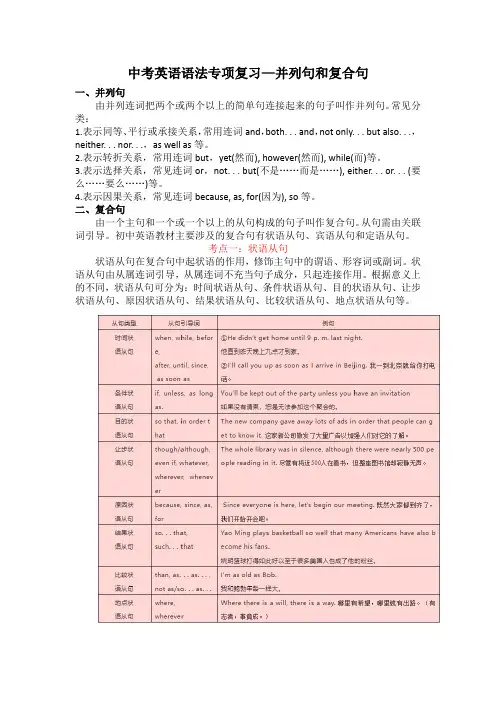
中考英语语法专项复习—并列句和复合句一、并列句由并列连词把两个或两个以上的简单句连接起来的句子叫作并列句。
常见分类:1.表示同等、平行或承接关系,常用连词and,both. . . and,not only. . . but also. . .,neither. . . nor. . .,as well as等。
2.表示转折关系,常用连词but,yet(然而), however(然而), while(而)等。
3.表示选择关系,常见连词or,not. . . but(不是……而是……), either. . . or. . . (要么……要么……)等。
4.表示因果关系,常见连词because, as, for(因为), so等。
二、复合句由一个主句和一个或一个以上的从句构成的句子叫作复合句。
从句需由关联词引导。
初中英语教材主要涉及的复合句有状语从句、宾语从句和定语从句。
考点一:状语从句状语从句在复合句中起状语的作用,修饰主句中的谓语、形容词或副词。
状语从句由从属连词引导,从属连词不充当句子成分,只起连接作用。
根据意义上的不同,状语从句可分为:时间状语从句、条件状语从句、目的状语从句、让步状语从句、原因状语从句、结果状语从句、比较状语从句、地点状语从句等。
状语从句的注意事项:1.条件状语从句和时间状语从句中的时态2.时间状语从句中not. . . until. . . (直到……才……)与before/ after引导的从句的转换。
I went to bed after I finished my homework.=I didn’t go to bed until I finished my homework.直到做完作业我才去睡觉。
3.结果状语从句中的特殊句式考点二:宾语从句(一)、定义在主从复合句中作宾语的句子叫作宾语从句。
(二)、宾语从句的四个考点【温馨提示】当主句谓语动词为think,suppose,guess, believe等词,主语为第一人称,从句表达否定意义时,形式上应否定主句。
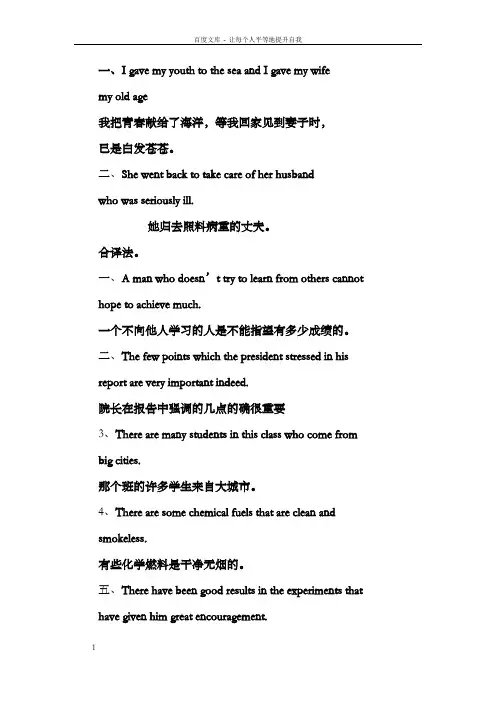
一、I gave my youth to the sea and I gave my wifemy old age我把青春献给了海洋,等我回家见到妻子时,已是白发苍苍。
二、She went back to take care of her husbandwho was seriously ill.她归去照料病重的丈夫。
合译法。
一、A man who doesn’t try to learn from others cannot hope to achieve much.一个不向他人学习的人是不能指望有多少成绩的。
二、The few points which the president stressed in his report are very important indeed.院长在报告中强调的几点的确很重要3、There are many students in this class who come from big cities.那个班的许多学生来自大城市。
4、There are some chemical fuels that are clean and smokeless.有些化学燃料是干净无烟的。
五、There have been good results in the experiments that have given him great encouragement.实验中的良好结果给了他莫大的鼓舞。
六、I need someone who can instruct me in my English study.我需要一个人来指导我学英语。
7、When I passed by, I saw a man who was writing something in the room.我从这里途经时,看到一个人在屋子里写字。
八、I have three letters which I must write this afternoon.我有三封信必需今天下午写出来。
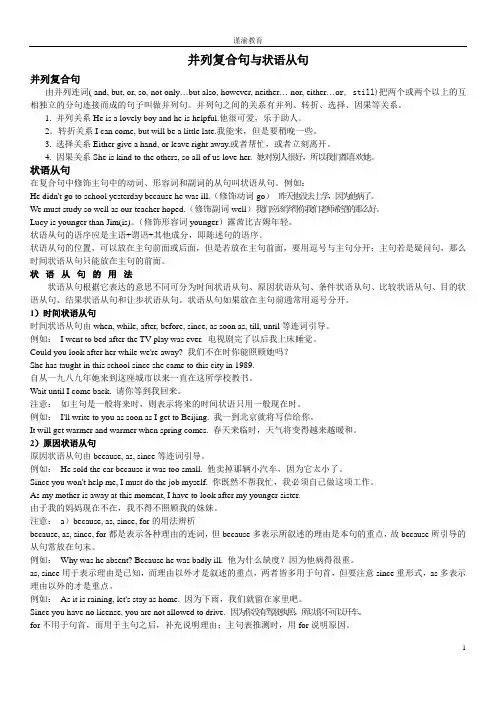
并列复合句与状语从句并列复合句由并列连词( and, but, or, so, not only…but also, however, neither… nor, either…o r, still)把两个或两个以上的互相独立的分句连接而成的句子叫做并列句。
并列句之间的关系有并列、转折、选择、因果等关系。
1. 并列关系He is a lovely boy and he is helpful.他很可爱,乐于助人。
2.转折关系I can come, but will be a little late.我能来,但是要稍晚一些。
3. 选择关系Either give a hand, or leave right away.或者帮忙,或者立刻离开。
4. 因果关系She is kind to the others, so all of us love her. 她对别人很好,所以我们都喜欢她。
状语从句在复合句中修饰主句中的动词、形容词和副词的从句叫状语从句。
例如:He didn't go to school yesterday because he was ill.(修饰动词go)昨天他没去上学,因为他病了。
We must study so well as our teacher hoped.(修饰副词well)我们应该学得你我们老师希望的那么好。
Lucy is younger than Jim(is)。
(修饰形容词younger)露茜比吉姆年轻。
状语从句的语序应是主语+谓语+其他成分,即陈述句的语序。
状语从句的位置,可以放在主句前面或后面,但是若放在主句前面,要用逗号与主句分开;主句若是疑问句,那么时间状语从句只能放在主句的前面。
状语从句的用法状语从句根据它表达的意思不同可分为时间状语从句、原因状语从句、条件状语从句、比较状语从句、目的状语从句、结果状语从句和让步状语从句。
状语从句如果放在主句前通常用逗号分开。
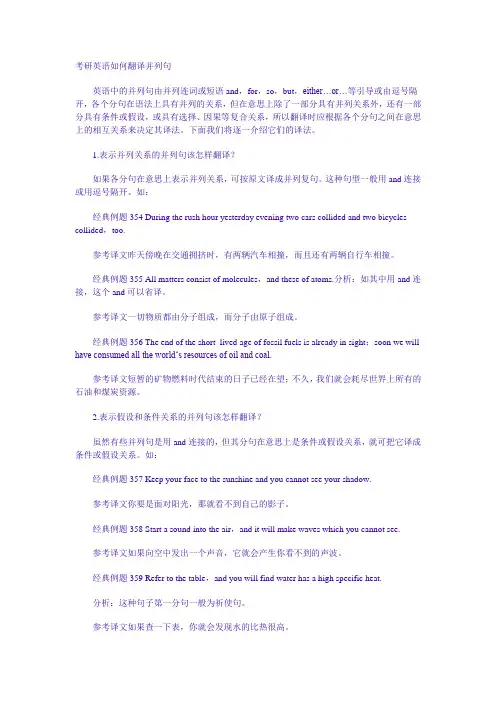
考研英语如何翻译并列句英语中的并列句由并列连词或短语and,for,so,but,either…or…等引导或由逗号隔开,各个分句在语法上具有并列的关系,但在意思上除了一部分具有并列关系外,还有一部分具有条件或假设,或具有选择、因果等复合关系,所以翻译时应根据各个分句之间在意思上的相互关系来决定其译法。
下面我们将逐一介绍它们的译法。
1.表示并列关系的并列句该怎样翻译?如果各分句在意思上表示并列关系,可按原文译成并列复句。
这种句型一般用and连接或用逗号隔开。
如:经典例题354 During the rush hour yesterday evening two cars collided and two bicycles collided,too.参考译文昨天傍晚在交通拥挤时,有两辆汽车相撞,而且还有两辆自行车相撞。
经典例题355 All matters consist of molecules,and these of atoms.分析:如其中用and连接,这个and可以省译。
参考译文一切物质都由分子组成,而分子由原子组成。
经典例题356 The end of the short_lived age of fossil fuels is already in sight;soon we will have consumed all the world…s resources of oil and coal.参考译文短暂的矿物燃料时代结束的日子已经在望;不久,我们就会耗尽世界上所有的石油和煤炭资源。
2.表示假设和条件关系的并列句该怎样翻译?虽然有些并列句是用and连接的,但其分句在意思上是条件或假设关系,就可把它译成条件或假设关系。
如:经典例题357 Keep your face to the sunshine and you cannot see your shadow.参考译文你要是面对阳光,那就看不到自己的影子。
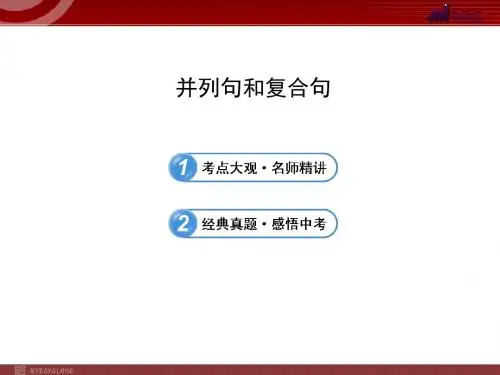
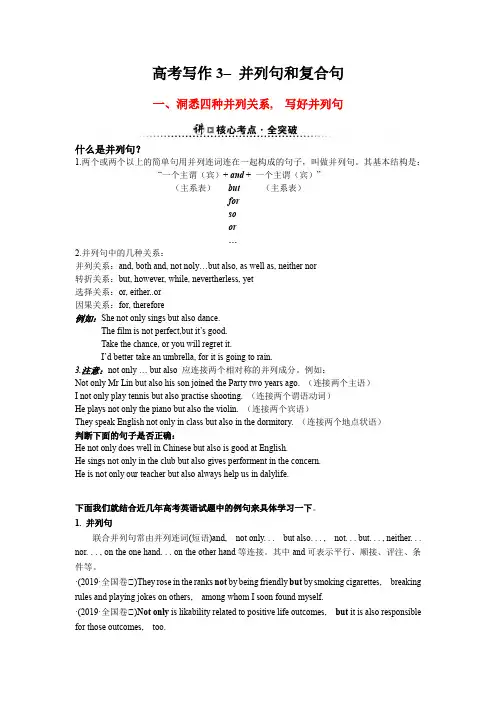
高考写作3– 并列句和复合句一、洞悉四种并列关系, 写好并列句什么是并列句?1.两个或两个以上的简单句用并列连词连在一起构成的句子,叫做并列句。
其基本结构是:“一个主谓(宾)+ and + 一个主谓(宾)”(主系表)but (主系表)forsoor…2.并列句中的几种关系:并列关系:and, both and, not noly…but also, as well as, neither nor转折关系:but, however, while, nevertherless, yet选择关系:or, either..or因果关系:for, therefore例如:She not only sings but also dance.The film is not perfect,but it’s good.Take the chance, or you will regret it.I’d better take an umbrella, for it is going to rain.3.注意:not only … but also 应连接两个相对称的并列成分。
例如:Not only Mr Lin but also his son joined the Party two years ago. (连接两个主语)I not only play tennis but also practise shooting. (连接两个谓语动词)He plays not only the piano but also the violin. (连接两个宾语)They speak English not only in class but also in the dormitory. (连接两个地点状语)判断下面的句子是否正确:He not only does well in Chinese but also is good at English.He sings not only in the club but also gives performent in the concern.He is not only our teacher but also always help us in dalylife.下面我们就结合近几年高考英语试题中的例句来具体学习一下。
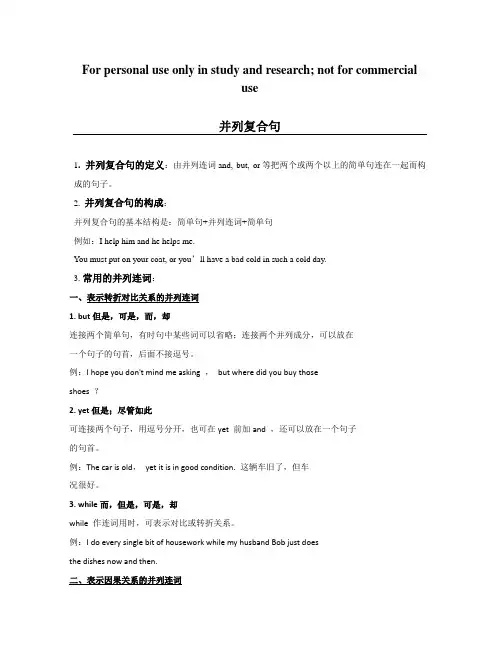
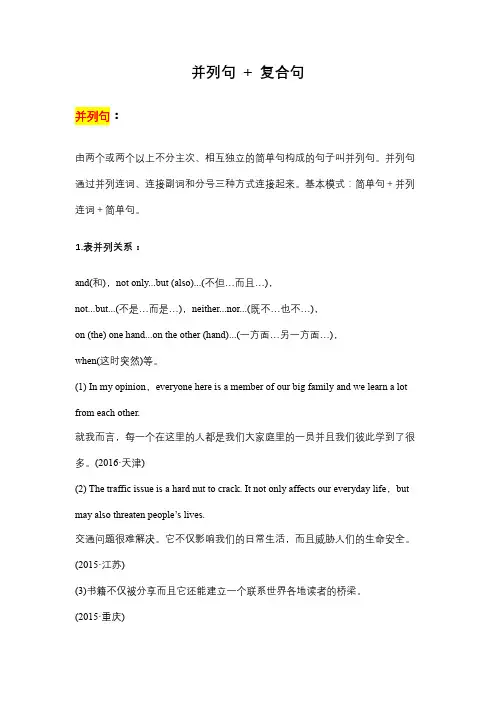
并列句+ 复合句并列句:由两个或两个以上不分主次、相互独立的简单句构成的句子叫并列句。
并列句通过并列连词、连接副词和分号三种方式连接起来。
基本模式:简单句+并列连词+简单句。
1.表并列关系:and(和),not only...but (also)...(不但…而且…),not...but...(不是…而是…),neither...nor...(既不…也不…),on (the) one hand...on the other (hand)...(一方面…另一方面…),when(这时突然)等。
(1) In my opinion,everyone here is a member of our big family and we learn a lot from each other.就我而言,每一个在这里的人都是我们大家庭里的一员并且我们彼此学到了很多。
(2016·天津)(2) The traffic issue is a hard nut to crack. It not only affects our everyday life,but may also threaten people’s lives.交通问题很难解决。
它不仅影响我们的日常生活,而且威胁人们的生命安全。
(2015·江苏)(3)书籍不仅被分享而且它还能建立一个联系世界各地读者的桥梁。
(2015·重庆)Not only are books shared but also it can build up a bridge connecting readers from different parts of the world as well.(4)我认为,儿子拒绝与他的母亲交流不是因为他没时间而是因为他不愿意。
(2013·重庆)In my opinion,the son refuses to municate with his mother not because he has no time but because he’s unwilling to.(5). 我正在去书店的路上,在一个十字路口等绿灯时,突然一个大约十岁的女孩被一辆过往的汽车撞倒,肇事车辆快速逃逸了。

初中英语分类练习——并列复合句与状语从句并列复合句由并列连词( and, but, or, so, not only…but also, however, neither… nor, either…o r, still)把两个或两个以上的互相独立的分句连接而成的句子叫做并列句。
并列句之间的关系有并列、转折、选择、因果等关系。
1. 并列关系He is a lovely boy and he is helpful.他很可爱,乐于助人。
2.转折关系I can come, but will be a little late.我能来,但是要稍晚一些。
3. 选择关系Either give a hand, or leave right away.或者帮忙,或者立刻离开。
4. 因果关系She is kind to the others, so all of us love her. 她对别人很好,所以我们都喜欢她。
状语从句在复合句中修饰主句中的动词、形容词和副词的从句叫状语从句。
例如:He didn't go to school yesterday because he was ill.(修饰动词go)昨天他没去上学,因为他病了。
We must study so well as our teacher hoped.(修饰副词well)我们应该学得你我们老师希望的那么好。
Lucy is younger than Jim (is)。
(修饰形容词younger)露茜比吉姆年轻。
状语从句的语序应是主语+谓语+其他成分,即陈述句的语序。
状语从句的位置,可以放在主句前面或后面,但是若放在主句前面,要用逗号与主句分开;主句若是疑问句,那么时间状语从句只能放在主句的前面。
状语从句的用法状语从句根据它表达的意思不同可分为时间状语从句、原因状语从句、条件状语从句、比较状语从句、目的状语从句、结果状语从句和让步状语从句。
状语从句如果放在主句前通常用逗号分开。
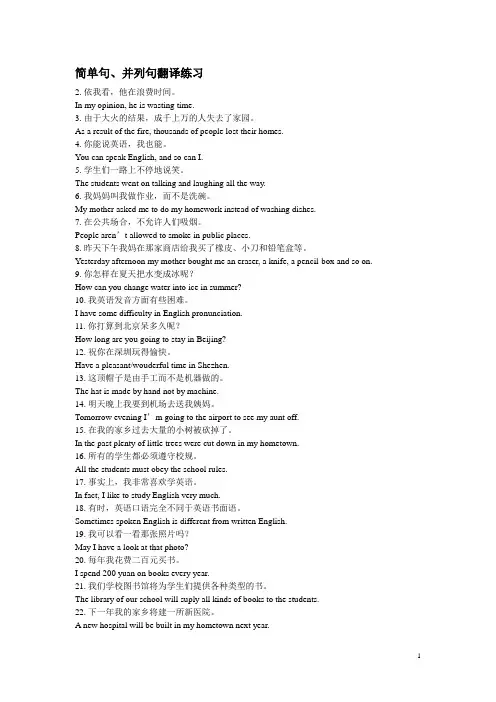
简单句、并列句翻译练习2. 依我看,他在浪费时间。
In my opinion, he is wasting time.3. 由于大火的结果,成千上万的人失去了家园。
As a result of the fire, thousands of people lost their homes.4. 你能说英语,我也能。
You can speak English, and so can I.5. 学生们一路上不停地说笑。
The students went on talking and laughing all the way.6. 我妈妈叫我做作业,而不是洗碗。
My mother asked me to do my homework instead of washing dishes.7. 在公共场合,不允许人们吸烟。
People aren’t allowed to smoke in public places.8. 昨天下午我妈在那家商店给我买了橡皮、小刀和铅笔盒等。
Yesterday afternoon my mother bought me an eraser, a knife, a pencil-box and so on.9. 你怎样在夏天把水变成冰呢?How can you change water into ice in summer?10. 我英语发音方面有些困难。
I have some difficulty in English pronunciation.11. 你打算到北京呆多久呢?How long are you going to stay in Beijing?12. 祝你在深圳玩得愉快。
Have a pleasant/wouderful time in Shezhen.13. 这顶帽子是由手工而不是机器做的。
The hat is made by hand not by machine.14. 明天晚上我要到机场去送我姨妈。
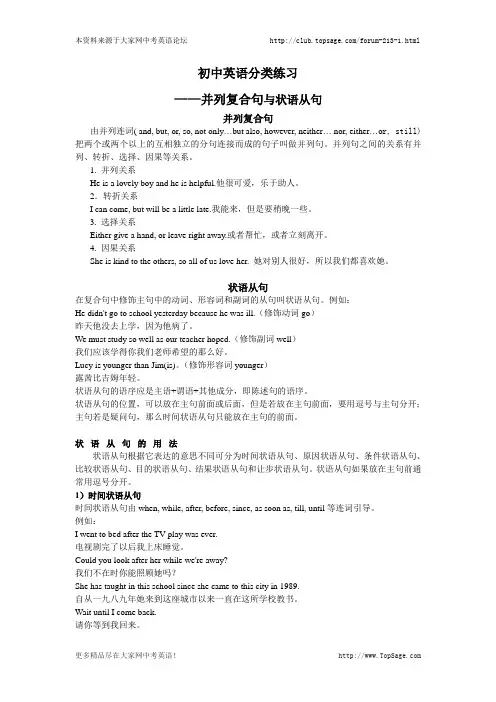
初中英语分类练习——并列复合句与状语从句并列复合句由并列连词( and, but, or, so, not only…but also, however, neither… nor, either…o r, still)把两个或两个以上的互相独立的分句连接而成的句子叫做并列句。
并列句之间的关系有并列、转折、选择、因果等关系。
1. 并列关系He is a lovely boy and he is helpful.他很可爱,乐于助人。
2.转折关系I can come, but will be a little late.我能来,但是要稍晚一些。
3. 选择关系Either give a hand, or leave right away.或者帮忙,或者立刻离开。
4. 因果关系She is kind to the others, so all of us love her. 她对别人很好,所以我们都喜欢她。
状语从句在复合句中修饰主句中的动词、形容词和副词的从句叫状语从句。
例如:He didn't go to school yesterday because he was ill.(修饰动词go)昨天他没去上学,因为他病了。
We must study so well as our teacher hoped.(修饰副词well)我们应该学得你我们老师希望的那么好。
Lucy is younger than Jim(is)。
(修饰形容词younger)露茜比吉姆年轻。
状语从句的语序应是主语+谓语+其他成分,即陈述句的语序。
状语从句的位置,可以放在主句前面或后面,但是若放在主句前面,要用逗号与主句分开;主句若是疑问句,那么时间状语从句只能放在主句的前面。
状语从句的用法状语从句根据它表达的意思不同可分为时间状语从句、原因状语从句、条件状语从句、比较状语从句、目的状语从句、结果状语从句和让步状语从句。
状语从句如果放在主句前通常用逗号分开。
并列句和并列复合句一、并列句1. 定义- 并列句是由两个或两个以上简单句并列在一起构成的句子。
这些简单句在语法上是平等的,互不依从。
例如:I like reading, and my sister likes dancing. 这里有两个简单句“I like reading”和“my sister likes dancing”,通过并列连词“and”连接起来。
2. 并列连词的用法- and(和、并且)- 表示并列、顺承或递进关系。
例如:He is tall and strong.(表示并列关系,描述他既高又壮);She got up early and had a good breakfast.(表示顺承关系,先起床然后吃了一顿丰盛的早餐)- but(但是)- 表示转折关系。
例如:I like English, but my brother likes math.(喜欢的学科不同,形成转折)- or(或者、否则)- 表示选择关系或者“否则”的意思。
例如:You can choose a book or a pen as a gift.(选择关系,在书和笔之间选择);Hurry up, or you will be late.(“否则”的意思,不快点就会迟到)- so(所以)- 表示因果关系。
例如:It rained heavily, so we stayed at home.(因为雨下得大,所以待在家里)3. 并列句的结构- 简单句+并列连词+简单句。
例如:She sings well, but she doesn't dance well. 第一个简单句“She sings well”,通过“but”这个并列连词连接第二个简单句“she doesn't dance well”。
4. 标点符号的使用- 在并列句中,当并列连词连接两个简单句时,一般情况下,在并列连词前可以使用逗号。
中考英语连词、复合句讲解一、连词:并列连词从属连词(一)并列连词:用来连接平行的词、词组或分句1. but:表转折“但是,然而”--- She is famous, but modest.--- She is not my daughter, but my nephew.--- It’s true he is young, but he is wise.注: (1) but 不与although 一起使用(2) not --- but --- “不是---而是—”(3) not only – but ( also ) --- “不但---而且—”2. and:表顺承---- He put on his coat and went out.---- It’s getting warmer and warmer.注: (1) 祈使句+and, 名词短语+and--- Word hard, and you will succeed.= If you work hard, you will succeed.--- One more effort, and you will succeed.(2) both --- and ---, 不但---而且—3. or:(1) 表选择“或”--- Which would you like, tea or coffee?(2) 表解释“即”--- This is a green house, or a hothouse.(3) 用于祈使句中,or表示“否则”--- Hurry up, or we will be late.= If we don’t hurry up, we will be late.(4) either ---or: 或者---或者4. so:(1) 所以:--- He was ill, so he didn’t attend the meeting.注:so和because 不能同时使用。